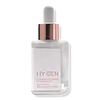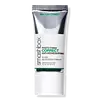What's inside
What's inside
 Key Ingredients
Key Ingredients

 Benefits
Benefits

 Concerns
Concerns

 Ingredients Side-by-side
Ingredients Side-by-side

Water
Skin ConditioningIsopentyldiol
HumectantButylene Glycol
HumectantGlycerin
HumectantPolyester-5
Mica
Cosmetic ColorantPolyacrylate Crosspolymer-11
Emulsion StabilisingPPG-26-Buteth-26
Skin ConditioningCaprylyl Glycol
EmollientPropanediol
SolventPEG-40 Hydrogenated Castor Oil
EmulsifyingPhenoxyethanol
PreservativePolyglyceryl-10 Eicosanedioate/Tetradecanedioate
Skin ConditioningSilica
AbrasiveEthylhexylglycerin
Skin ConditioningHexylene Glycol
EmulsifyingParfum
MaskingSodium Hyaluronate
HumectantPotassium Hydroxide
BufferingSodium Phosphate
BufferingLinalool
PerfumingSodium Acetate
BufferingCitronellol
PerfumingNonapeptide-1
Skin ConditioningPentylene Glycol
Skin ConditioningCitric Acid
BufferingFructose
HumectantSodium Hydroxide
BufferingTetraselmis Suecica Extract
Skin ConditioningUrea
BufferingPrunus Persica Fruit Extract
AbrasiveAllantoin
Skin ConditioningMaltose
MaskingSodium Benzoate
MaskingSodium Chloride
MaskingSodium Lactate
BufferingSodium PCA
HumectantTrehalose
HumectantLactic Acid
BufferingPotassium Sorbate
PreservativeGlucose
HumectantDisodium Phosphate
BufferingCI 77891
Cosmetic ColorantWater, Isopentyldiol, Butylene Glycol, Glycerin, Polyester-5, Mica, Polyacrylate Crosspolymer-11, PPG-26-Buteth-26, Caprylyl Glycol, Propanediol, PEG-40 Hydrogenated Castor Oil, Phenoxyethanol, Polyglyceryl-10 Eicosanedioate/Tetradecanedioate, Silica, Ethylhexylglycerin, Hexylene Glycol, Parfum, Sodium Hyaluronate, Potassium Hydroxide, Sodium Phosphate, Linalool, Sodium Acetate, Citronellol, Nonapeptide-1, Pentylene Glycol, Citric Acid, Fructose, Sodium Hydroxide, Tetraselmis Suecica Extract, Urea, Prunus Persica Fruit Extract, Allantoin, Maltose, Sodium Benzoate, Sodium Chloride, Sodium Lactate, Sodium PCA, Trehalose, Lactic Acid, Potassium Sorbate, Glucose, Disodium Phosphate, CI 77891
Water
Skin ConditioningDimethicone
EmollientVinyl Dimethicone/Methicone Silsesquioxane Crosspolymer
Methyl Trimethicone
Skin ConditioningButylene Glycol
HumectantDimethicone/Vinyl Dimethicone Crosspolymer
Skin ConditioningGlycerin
HumectantSilica
AbrasiveHydroxyethyl Urea
HumectantAlgae Extract
EmollientRosa Hybrid Flower Extract
Skin ConditioningFuscoporia Obliqua Sclerotium Extract
Skin ConditioningLycium Chinense Fruit Extract
AntioxidantLactobacillus Ferment
Skin ConditioningVaccinium Angustifolium Fruit Extract
Skin ProtectingVaccinium Macrocarpon Fruit Extract
AstringentPoria Cocos Sclerotium Extract
AstringentCaffeine
Skin ConditioningYeast Extract
Skin ConditioningSorbitol
HumectantSodium Polyaspartate
HumectantEthylhexylglycerin
Skin ConditioningPantethine
EmollientTrehalose
HumectantSodium Hyaluronate
HumectantIsohexadecane
EmollientIsopropyl Isostearate
EmollientPPG-15 Stearyl Ether
EmollientPEG-8 Dimethicone
EmulsifyingPolyglyceryl-3 Disiloxane Dimethicone
Skin ConditioningPolyglyceryl-3 Polydimethylsiloxyethyl Dimethicone
Skin ConditioningTrimethylsiloxysilicate
EmollientAmmonium Acryloyldimethyltaurate/Vp Copolymer
Acrylamide/Sodium Acryloyldimethyltaurate Copolymer
Emulsion StabilisingPolysorbate 80
EmulsifyingDisodium EDTA
Tin Oxide
AbrasiveCellulose
AbsorbentSynthetic Fluorphlogopite
Triethoxycaprylylsilane
Tocopheryl Acetate
AntioxidantTocopherol
AntioxidantBHT
AntioxidantSodium Dehydroacetate
PreservativePotassium Sorbate
PreservativePhenoxyethanol
PreservativeCI 77891
Cosmetic ColorantCI 77288
Cosmetic ColorantMica
Cosmetic ColorantCI 77163
Cosmetic ColorantCI 77492
Cosmetic ColorantWater, Dimethicone, Vinyl Dimethicone/Methicone Silsesquioxane Crosspolymer, Methyl Trimethicone, Butylene Glycol, Dimethicone/Vinyl Dimethicone Crosspolymer, Glycerin, Silica, Hydroxyethyl Urea, Algae Extract, Rosa Hybrid Flower Extract, Fuscoporia Obliqua Sclerotium Extract, Lycium Chinense Fruit Extract, Lactobacillus Ferment, Vaccinium Angustifolium Fruit Extract, Vaccinium Macrocarpon Fruit Extract, Poria Cocos Sclerotium Extract, Caffeine, Yeast Extract, Sorbitol, Sodium Polyaspartate, Ethylhexylglycerin, Pantethine, Trehalose, Sodium Hyaluronate, Isohexadecane, Isopropyl Isostearate, PPG-15 Stearyl Ether, PEG-8 Dimethicone, Polyglyceryl-3 Disiloxane Dimethicone, Polyglyceryl-3 Polydimethylsiloxyethyl Dimethicone, Trimethylsiloxysilicate, Ammonium Acryloyldimethyltaurate/Vp Copolymer, Acrylamide/Sodium Acryloyldimethyltaurate Copolymer, Polysorbate 80, Disodium EDTA, Tin Oxide, Cellulose, Synthetic Fluorphlogopite, Triethoxycaprylylsilane, Tocopheryl Acetate, Tocopherol, BHT, Sodium Dehydroacetate, Potassium Sorbate, Phenoxyethanol, CI 77891, CI 77288, Mica, CI 77163, CI 77492
 Reviews
Reviews

Ingredients Explained
These ingredients are found in both products.
Ingredients higher up in an ingredient list are typically present in a larger amount.
Butylene Glycol (or BG) is used within cosmetic products for a few different reasons:
Overall, Butylene Glycol is a safe and well-rounded ingredient that works well with other ingredients.
Though this ingredient works well with most skin types, some people with sensitive skin may experience a reaction such as allergic rashes, closed comedones, or itchiness.
Learn more about Butylene GlycolCi 77891 is a white pigment from Titanium dioxide. It is naturally found in minerals such as rutile and ilmenite.
It's main function is to add a white color to cosmetics. It can also be mixed with other colors to create different shades.
Ci 77891 is commonly found in sunscreens due to its ability to block UV rays.
Learn more about CI 77891Ethylhexylglycerin (we can't pronounce this either) is commonly used as a preservative and skin softener. It is derived from glyceryl.
You might see Ethylhexylglycerin often paired with other preservatives such as phenoxyethanol. Ethylhexylglycerin has been found to increase the effectiveness of these other preservatives.
Glycerin is already naturally found in your skin. It helps moisturize and protect your skin.
A study from 2016 found glycerin to be more effective as a humectant than AHAs and hyaluronic acid.
As a humectant, it helps the skin stay hydrated by pulling moisture to your skin. The low molecular weight of glycerin allows it to pull moisture into the deeper layers of your skin.
Hydrated skin improves your skin barrier; Your skin barrier helps protect against irritants and bacteria.
Glycerin has also been found to have antimicrobial and antiviral properties. Due to these properties, glycerin is often used in wound and burn treatments.
In cosmetics, glycerin is usually derived from plants such as soybean or palm. However, it can also be sourced from animals, such as tallow or animal fat.
This ingredient is organic, colorless, odorless, and non-toxic.
Glycerin is the name for this ingredient in American English. British English uses Glycerol/Glycerine.
Learn more about GlycerinMica is a naturally occurring mineral used to add shimmer and color in cosmetics. It can also help improve the texture of a product or give it an opaque, white/silver color.
Serecite is the name for very fine but ragged grains of mica.
This ingredient is often coated with metal oxides like titanium dioxide. Trace amounts of heavy metals may be found in mica, but these metals are not harmful in our personal products.
Mica has been used since prehistoric times throughout the world. Ancient Egyptian, Indian, Greek, Roman, Aztec, and Chinese civilizations have used mica.
Learn more about MicaPhenoxyethanol is a preservative that has germicide, antimicrobial, and aromatic properties. Studies show that phenoxyethanol can prevent microbial growth. By itself, it has a scent that is similar to that of a rose.
It's often used in formulations along with Caprylyl Glycol to preserve the shelf life of products.
Potassium Sorbate is a preservative used to prevent yeast and mold in products. It is commonly found in both cosmetic and food products.
This ingredient comes from potassium salt derived from sorbic acid. Sorbic acid is a natural antibiotic and effective against fungus.
Both potassium sorbate and sorbic acid can be found in baked goods, cheeses, dried meats, dried fruit, ice cream, pickles, wine, yogurt, and more.
You'll often find this ingredient used with other preservatives.
Learn more about Potassium SorbateSilica, also known as silicon dioxide, is a naturally occurring mineral. It is used as a fine, spherical, and porous powder in cosmetics.
Though it has exfoliant properties, the function of silica varies depending on the product.
The unique structure of silica enhances the spreadability and adds smoothness, making it a great texture enhancer.
It is also used as an active carrier, emulsifier, and mattifier due to its ability to absorb excess oil.
In some products, tiny microneedles called spicules are made from silica or hydrolyzed sponge. When you rub them in, they lightly polish away dead skin layers and enhance the penetration of active ingredients.
Learn more about SilicaSodium Hyaluronate is hyaluronic acid's salt form. It is commonly derived from the sodium salt of hyaluronic acid.
Like hyaluronic acid, it is great at holding water and acts as a humectant. This makes it a great skin hydrating ingredient.
Sodium Hyaluronate is naturally occurring in our bodies and is mostly found in eye fluid and joints.
These are some other common types of Hyaluronic Acid:
Learn more about Sodium HyaluronateTrehalose is a disaccharide made of two glucose molecules (glucose is sugar!). Trehalose is used to help moisturize skin. It also has antioxidant properties.
As a humectant, trehalose helps draw moisture from the air to your skin. This helps keep your skin hydrated.
Due to its antioxidant properties, trehalose may help with signs of aging. Antioxidants help fight free-radical molecules, unstable molecules that may damage your skin.
In medicine, trehalose and hyaluronic acid are used to help treat dry eyes.
Some animals, plants, and bacteria create trehalose as a source of energy to survive freeze or lack of water.
Learn more about TrehaloseWater. It's the most common cosmetic ingredient of all. You'll usually see it at the top of ingredient lists, meaning that it makes up the largest part of the product.
So why is it so popular? Water most often acts as a solvent - this means that it helps dissolve other ingredients into the formulation.
You'll also recognize water as that liquid we all need to stay alive. If you see this, drink a glass of water. Stay hydrated!
Learn more about Water